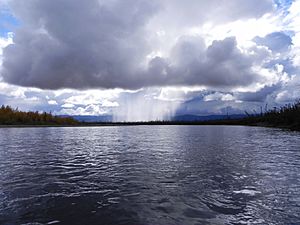Birch Creek (Yukon River tributary) facts for kids
Quick facts for kids Birch Creek |
|
|---|---|

Rain along Birch Creek
|
|
|
Location of the mouth of Birch Creek in Alaska
|
|
| Country | United States |
| State | Alaska |
| Census Area | Yukon–Koyukuk |
| Physical characteristics | |
| Main source | confluence of Ptarmigan and Eagle creeks near Porcupine Dome 2,275 ft (693 m) 65°26′19″N 145°31′36″W / 65.43861°N 145.52667°W |
| River mouth | beginning of distributaries, Upper Mouth Birch Creek and Lower Mouth Birch Creek upstream on Birch Creek from distributaries' mouths on the Yukon River, Yukon Flats National Wildlife Refuge 453 ft (138 m) 66°16′13″N 145°30′15″W / 66.27028°N 145.50417°W |
| Length | 150 mi (240 km) |
| Type: | Wild |
| Designated: | December 2, 1980 |
Birch Creek is a long river in Alaska, a state in the United States. It flows for about 150 miles (240 km) and eventually joins the mighty Yukon River. The creek starts where two smaller streams, Ptarmigan and Eagle creeks, meet near a place called Porcupine Dome.
As Birch Creek flows, it passes under the Steese Highway and goes through the Steese National Conservation Area. It then enters the Yukon Flats National Wildlife Refuge. Finally, it splits into two smaller rivers, called distributaries, which flow into the Yukon River at different spots near Fort Yukon.
Contents
History of Birch Creek
Early People and Gold Discovery
The first people to live near Birch Creek were likely the Gwich'in people. They hunted animals and fished in the creek for their food.
In 1893, something exciting happened: gold was found along the creek! This discovery led to the creation of Circle City. It became the first gold town in the Alaska Interior region. Miners there made their own rules in special meetings. Even today, you can still see old mining and trapping cabins along Birch Creek. People continue to mine for gold in the area.
Birch Creek's Branches
Upper Mouth Birch Creek
Birch Creek doesn't just end in one place. It splits into two main branches, called distributaries. One of these is called Upper Mouth Birch Creek.
This branch flows about 35 miles (56 km) to the northwest. It then joins the Yukon River about 25 miles (40 km) southwest of Fort Yukon.
Lower Mouth Birch Creek
The other main branch is Lower Mouth Birch Creek. This branch flows about 50 miles (80 km) to the southwest.
It connects to a waterway called Lower Birch Creek Slough. This slough is like a side channel of the Yukon River. It flows for about 15 miles (24 km) next to the main river.
Fun Things to Do at Birch Creek
Wild and Scenic River Status
A large part of Birch Creek, about 126 miles (203 km), is special. In 1980, it was named a "wild" river as part of the National Wild and Scenic Rivers System. This means it's protected for its natural beauty.
The Bureau of Land Management (BLM) helps manage this area. They have special spots along the Steese Highway where people can start and end their river trips.
Boating Adventures
If you like boating, you can float down Birch Creek in a canoe, kayak, or raft. You can start at one BLM spot and travel about 110 miles (177 km) downstream to another.
Most of the creek is easy to float, rated Class I. But some parts are a bit harder, rated Class II (medium) or Class III (difficult).
Fishing Fun
Birch Creek is a great place for fishing! You can catch fish like northern pike and Arctic grayling. Fishing here can be "outstanding," according to a book called Alaska Fishing.
- Northern Pike: These bigger fish are often found in the lower parts of the creek. They also like the quiet side channels, ponds, and old river bends in the Yukon Flats.
- Arctic Grayling: These fish prefer the cooler, clearer waters closer to where the creek begins.
There are no official camping spots along the creek. But many people set up their tents on the gravel bars in the river.
Winter Activities
In February, Birch Creek becomes part of a famous race. It's used as a trail for the Yukon Quest, a 1,000-mile (1,600 km) sled dog race.
Other fun things to do in winter include:
- Dog mushing (traveling with sled dogs)
- Trapping
- Cross-country skiing


